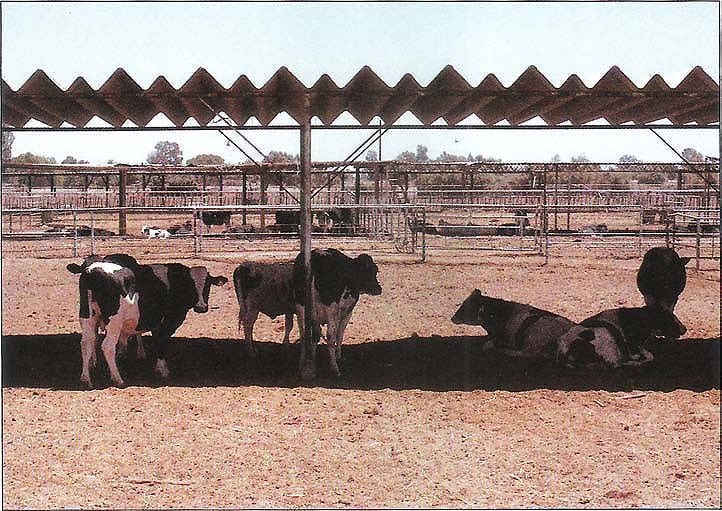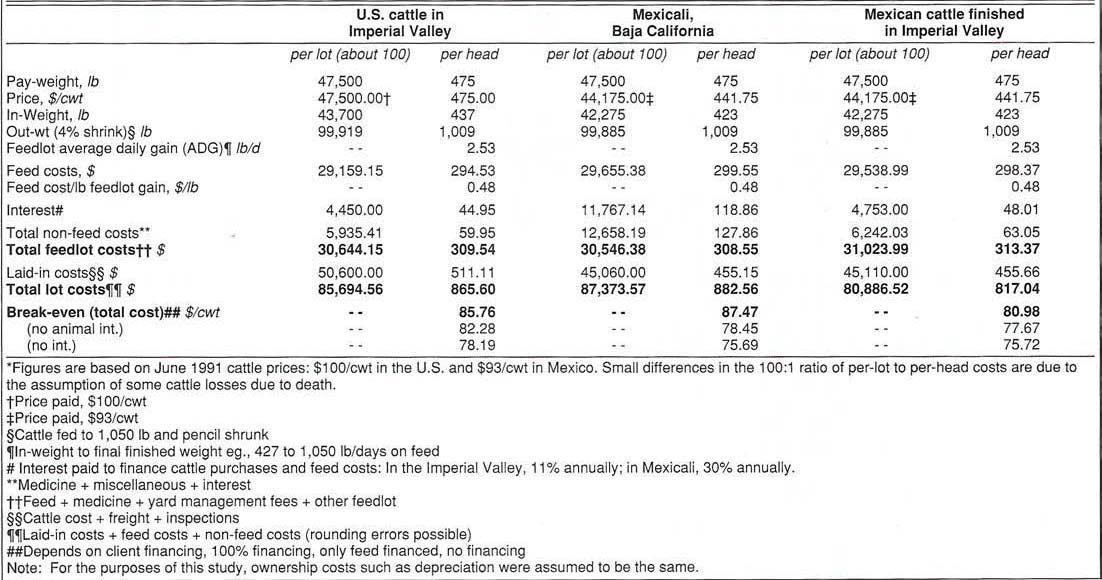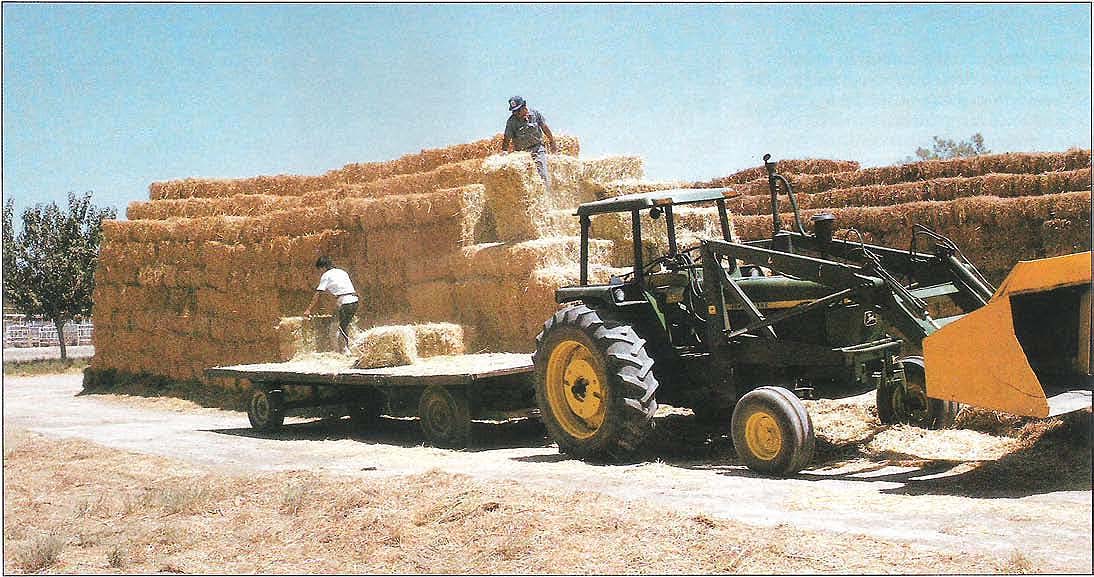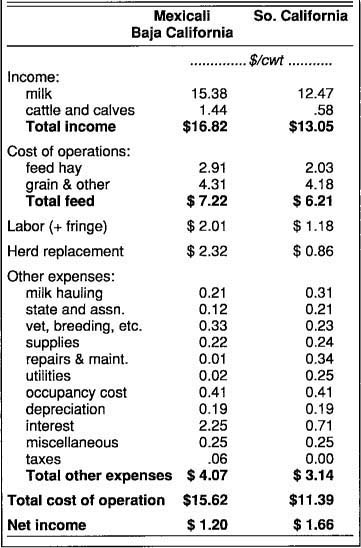All Issues
U.S.-Mexico production costs compared: At present, livestock production more favorable in Imperial Valley
Publication Information
California Agriculture 45(5):18-21.
Published September 01, 1991
PDF | Citation | Permissions
Abstract
Cattle production rates and feed costs are similar in Baja California and Southern California. However, Mexican feedlot and dairy enterprises have higher finance charges and higher total production costs than comparable U.S. enterprises. Assuming current feedlot costs and livestock prices, the most cost-effective system of producing livestock in the Southwest is to maintain the cowherd in Mexico but to feed the calves to slaughter in the Imperial Valley. With current dairy costs and prices, dairy cattle production is more favorable in Southern California than in Baja California.
Full text
Shades and misting prevent heat stress in Holstein cows at Ganadera Imperial, a technically-advanced dairy in Mexicali.
The U.S., Mexico and Canada have agreed to enter negotiations regarding a North American Free Trade Agreement. A North American trading partnership would create the largest economic trading block in the world. What will be the effects of a free trade agreement (FTA) on livestock producers along the California-Baja California border? Although feedlot and dairy production practices and rates are similar on both sides of the border, producers need to know the comparative costs of production if they are to determine where advantages lie. Such information might also be useful to local governments and to those persons negotiating the FTA to assess the effects of an FTA on the livestock sector of the agricultural economy along the California-Baja California border.
At present the cattle population in Mexico is about 30 million head with 5 million head in the state of Sonora. Sonora herds provide feeder cattle for livestock and dairy operations in both Baja California and Southern California. The cattle population of California is currently 4.7 million head.
Methods
A work group consisting of University of California Cooperative Extension (CE) livestock advisors and faculty from the Institute for Research in Veterinary Science of the Autonomous University of Baja California (UABC) was formed. Both CE advisors and UABC faculty were familiar with specific livestock production practices and costs in their countries. The joint work group permitted a better understanding of each other's particular practices and helped to avoid errors due to the lack of understanding of country-specific practices.
To obtain the specific Mexican data, CE advisors with UABC faculty visited the regional cattle feeders' association and the regional dairy producers' association in Mexicali. Both Mexicali livestock producers associations provided the work group with the data that were required. Prior to data analyses, the group visited 6 feedlots and dairies to verify the data. For the last year, peso-dollar exchange rates have been rather stable, changing only several pesos per month. Mexican pesos were converted to U.S. dollars at 3,000 to 1, kilograms to avoirdupois weights, metric tons to short tons, and hectares to acres.
The most difficult task in a study of this type is understanding Mexican accounting systems, labor laws, social security laws, and Mexican insurance systems and deciding into which line-item of a U.S. budget to place such Mexican costs. Mexican labor costs such as social security and mandatory health insurance were grouped in “labor + fringe” costs of table 2. Mexican labor usage costs were also grouped in that category, while production insurance charges and financial charges were included in miscellaneous expenses. Cost production data for these analyses represent sample actual costs during early June 1991 from both Southern California and Baja California.
At the present time Mexico has a total cattle population of about 30 million head, about 5 million head of cattle are in the neighboring state of Sonora, and Baja California-North has about 70,000 head of dairy cattle. California has a total cattle population of about 4.7 million while Southern California alone has about 300,000 head of dairy cattle.
Feedlot
In the commercial cattle feeding industry, lot close-outs are provided to customers who use them to generate their own profit-loss statements. The lot close-out provides details of the cattle lot's biological performance and efficiency, including feed costs, non-feed costs, total lot costs, and the required break-even costs for the finished cattle. Unfortunately in California, lot close-outs across feedlots do not conform to the same model so cattle performance comparisons based on close-outs between feedlots are difficult. A university textbook close-out model developed at Texas A & M University was selected to compare commercial cattle feeding in the Imperial and Mexicali valleys. Feedlot cattle in Mexico are generally not fed on a custom basis; the feedlots themselves own the cattle. The Baja California data in the close-out model were taken from Mexican cattle-feeding data analyzed using a standard U.S. feedlot cost projection model developed at UC Davis. The feedlot model estimates weight gain, feeding costs, interest charges, and total lot costs.
Cattle feeding costs were compared under three scenarios for a small lot of 100 calves: calves of U.S. origin fed in the Imperial Valley, Mexican cattle fed in Mexicali, and Mexican cattle fed in the Imperial Valley given an FTA. The model assumed the following: calves were purchased weighing 475 lb, calves were fed continuously in the feedlot to a finished weight of 1,050 lb (in Mexicali, calves are normally pasture-fed prior to finish and fed to about 930 lb), and cattle performance was the same in both countries. With adequate ration formulation and milling there is no biological reason that Mexican cattle can not perform the same as in the Imperial Valley. Feedlot cattle in Mexicali generally gain about 2.5 lb/day but performance varies greatly among feedlots. In the Imperial Valley, cattle gains of 2.65 lb/day are common.
The model assumed that under an FTA there would be no tariffs and that to import cattle from Mexicali to the Imperial Valley would cost $4.50 per head for inspection fees and transit costs. In the Imperial Valley costs for the starting, growing and finishing rations were $115, $125 and $145 per ton (t), respectively. In Mexicali costs for the starting, growing and finishing rations were $125, $135 and $145/t, respectively. Feedlot cost analyses assumed 30% and 11% annual interest rates in Mexicali and the Imperial Valley, respectively. In a commercial feedlot each cattle investor may have a different amount of equity in the cattle, but this model assumed that all the cattle purchase costs and all the feed were financed.
Dairy
In the U.S. dairy industry the producer is paid per hundredweight (cwt) of milk shipped. For this reason, it is a common practice to analyze all income and costs on a hundredweight basis. This method allows us to compare production costs in regions with very different herd sizes. In this study an average-sized Southern California herd (900 cows) was compared to a 250-cow Mexicali herd. In Baja California there is only one milk price, while California has a three-tiered system. In this comparison it was assumed that 95% of the milk shipped from the California dairy would command the highest price. Feed costs were based on current prices paid in each location for similar alfalfa hay and for commercially prepared grain mixes. Actual Mexican labor usage and financial charges were used in the U.S. model (the Southern Counties Dairy Model developed at UC Davis Cooperative Extension).
The objective of this study was to compare actual livestock production practices and actual cash expenses along the California-Baja California border with livestock cost projection models available to U.S. producers. It was not our intent to make extensive comments on economic theories regarding interest rates, real interest rates, capital investments, or inflation.
Results
Feedlot comparison
Comparative feedlot costs between the Imperial and Mexicali valleys are presented in table 1 using a reduced lot close-out format. In June 1991, with the cost of U.S. feeder cattle rising and a declining fed-cattle price (prices declined from $78 to $71/ cwt), market break-even prices were relatively high. Given the calculated breakeven-prices (table 1) for cattle of U.S. origin in June 1991, Imperial Valley feedlot purchases of cattle declined dramatically, according to the monthly California Livestock Review (published by the California Agricultural Statistics Service).
Assuming an FTA, where would be the most profitable location for feeding Mexican cattle? When all costs are considered, break-even prices are higher in Mexicali than in California. We assumed that cattle will perform the same in Mexico as in the U.S. That may not be so under all circumstances. However, given the real possibility of an FTA in the future, the Mexican feedlot industry must become as efficient as the Imperial Valley industry if it is to remain competitive. Interest costs, based on 30% interest rates for the Mexicali Valley and 11% interest rates for the Imperial Valley, were $11,676.14 and $4,753.00, respectively. “Total feedlot costs” for 100 calves – figures excluding interest charges – were similar for the two areas: $30,546.38 in Mexicali and $31,023.99 in the Imperial Valley. However, higher Mexican interest charges were reflected in “total lot costs” (including cattle costs, freight, interest, and feedlot charges). For the same 100 Mexican calves, total lot costs were $87,373.57 in Mexicali and $80,886.52 in the Imperial Valley.
TABLE 1. Comparative costs of feedlot cattle production along California/Baja California border for feeding a lot of 100 calves*
Considering all costs for the current feeding system in Baja California, where cattle are not custom-fed, the break-even prices for cattle were $87.47/cwt in Mexicali and $80.98/cwt in the Imperial Valley. Only under the assumption of similar cattle performance and no interest charges were break-even prices similar for the Mexicali and Imperial Valleys, $75.69 and $75.72/cwt, respectively. Of the three scenarios compared, and with current livestock practices and costs under an FTA, the most cost-effective production system would be to feed Mexican calves in Imperial Valley feedlots.
Dairy comparison
Comparative dairy production costs between Southern California and Mexicali are presented in table 2. Milk prices are higher in Baja California than in Southern California, $15.38 and $12.47/cwt; respectively. Total income is $16.82 and $13.05/cwt in Mexicali and in Southern California, respectively. Feed costs are higher in Mexicali than in California, $7.22 vs. $6.21/cwt. Annual interest rates of 29% in Mexicali vs. 11 % in California resulted in interest costs of $2.25 and $0.71 /cwt, respectively. Higher feed costs, higher heifer death losses, a slightly lower reproductive rate, and necessary heifer purchases to maintain herd size made replacement costs higher in Mexicali. Replacement costs were $2.32/cwt in Mexicali and $0.86/cwt in Southern California. Total costs of operation per hundredweight of milk for Mexicali and Southern California were $15.65 and $11.39, respectively. Southern California dairies have a higher net return per hundredweight of milk than those in Mexicali, $1.66 vs. $1.20, respectively.
Some U.S. agricultural interests have complained about the unfair labor advantage of “cheap” Mexican labor. This livestock study does not confirm such an advantage. The feedlot close-out does not have a separate “labor” line-item. However on our tours of Mexicali feedlots it was common to encounter 15 to 18 people working in feedlots of 4,000 head of cattle. In the Imperial Valley there are an average of 1.5 to 2 persons per 1,000 head of cattle. Southern California dairies generally have one person per 100 to 150 cows. The 250-cow hypothetical Mexicali dairy has 15 persons employed. For Mexicali and Southern California dairies, labor costs are $2.01 and $1.18/cwt of milk produced, respectively. However, we must note that in countries with high interest rates and high capital investment costs it is often more cost-effective to use manual labor than to make expensive capital investments. Although the Mexicali livestock enterprise does have lower per-hour wage rates than does California, when labor productivity costs are included in comparative costs, total Mexican livestock labor is not “cheaper”.
For both the feedlot and the dairy examples, the largest contributor to the higher production costs in Baja California compared to California was interest costs. At the present time Mexico has about a 24% annual inflation rate compared to 5 to 6% in the U.S., consequently the real interest rate would be much less than the 30% charged by the banks, however such economic arguments are beyond the scope of this study, which focuses on actual cash outlays.
Conclusions and implications
Cattle biological productivity in Baja California is comparable to that of Southern California. Feedlot average daily gains in Mexicali and in the Imperial Valley are about 2.5 and 2.65 lb/day, respectively. Milk yields in Mexicali and in Southern California are 17,260 and 18,500 lb/cow/ year, respectively-Baja California livestock producers are generally quick to adopt new technologies.
Depending upon the specifics of the FTA, a reduced or tariff-free FTA will present new challenges to livestock producers along the border. Competition along the border in livestock production may result in each side seeking its own particular production ‘niche’. A different beef product is acceptable in Baja California; steers may be finished at 930 lb or bulls might be fed. Commodities and resources could be shared along the border. U.S.-bound cattle might be pastured in Baja California and later finished in Imperial Valley feedlots. If Baja California livestock producers could increase their importation of cheaper U.S. feed grains and byproducts without tariffs or quotas, Mexican livestock feeding costs would decrease. If lower interest rates due to further changes in Mexican banking laws were to result because of an FTA, the Mexican livestock production sector would benefit enormously. Baja California feed byproducts might be used in California. Beef and milk could be produced in California and then processed in Mexican plants under U.S. Department of Agriculture certification and reintroduced into California, if U.S. laws could be amended to permit U.S.-produced beef and milk to retain its origin when re-imported.








